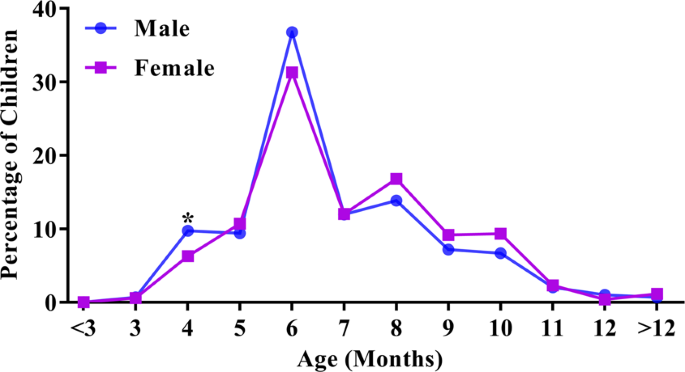
Associations of maternal, perinatal and postnatal factors with the eruption timing of the first primary tooth
- Select a language for the TTS:
- UK English Female
- UK English Male
- US English Female
- US English Male
- Australian Female
- Australian Male
- Language selected: (auto detect) - EN
Play all audios:
We recruited 1296 mothers in their first trimester from the Affiliated Obstetrics and Gynecology Hospital of Nanjing Medical University between May 2014 and September 2015 to investigate the
associations of maternal, perinatal and postnatal factors with the eruption timing of the first primary tooth (ETFPT) in a Chinese population. We collected maternal demographic information
and clinical data during the perinatal and postnatal period, and oral examinations of the infants were performed by a doctor at 6, 9 and 12 months of age. Multiple regression analysis was
used to identify significant explanatory variables for ETFPT. The mean age at eruption of the first primary tooth for all the infants was 6.82 ± 1.90 months. After adjustment for
confounders, higher maternal childbearing age (β = 0.57; 95%CI = 0.13–1.02), female sex (β = 0.26; 95%CI = 0.07–0.52), and low birth weight (β = 0.98; 95%CI = 0.20–1.76) were significantly
associated with delayed eruption of the first primary tooth, while macrosomia (β = −0.79; 95%CI = −1.30–−0.28) was significantly associated with earlier eruption of the first primary tooth.
Maternal childbearing age, infant sex and infant birth weight were significant determinants of ETFPT.
The formation and development of human primary teeth begins at the end of the fifth week of gestation1. Teeth are formed in the upper and lower jaw through mutual, subtle and sophisticated
interactions between the dental epithelium and oral ectomesenchyme involving the expression of several tooth-related genes1. Primary tooth eruption is a complex and highly regulated process
in which teeth enter the mouth and become visible during a certain time period. In most infants, the first primary tooth to erupt is the central mandibular incisor, which erupts between 2
and 15 months of age2. The complete primary dentition erupts from 10 to 33 months depending on the position and type of tooth3.
Variations in the eruption timing of the first primary tooth (ETFPT) are considered multifactorial. Eruption is under strong genetic control, and the estimates of narrow-sense heritability
are over 70%4. Furthermore, genome-wide association studies (GWAS) have identified some candidate genes associated with tooth development, such as KCNJ2, EDA, HOXB2, RAD51L1, IGF2BP1, HMGA2
and MSRB35. There are ethnicity- and sex-related differences in the timing of primary tooth eruption6. However, external environmental factors also make significant contributions to the
timing of the primary tooth eruption. Maternal exposure to tobacco during pregnancy7,8, infant birth weight9,10, birth length11, nutritional state at birth and at postnatal timepoints12,
gestational age13, method of infant feeding8,14 and socioeconomic situation15 have been reported to be significant determinants of the eruption of primary teeth. Delayed tooth eruption has
been reported in premature infants13,16 with small gestational age and low birth weight and in those with systemic disorders, such as hypothyroidism17, while accelerated tooth eruption has
been observed in children whose mothers smoked during pregnancy7,8 as well as in those with childhood obesity18 and diabetes mellitus19.
Although several studies have examined the factors influencing tooth eruption, their results are inconsistent8,14,20,21,22. Most of the studies focused only on factors within a defined
period of time and based their findings on evidence from small cohorts, while some studies focused on the whole pregnancy. A prospective cohort study in Turkey23 found that growth parameters
and feeding patterns may be determinants of the timing of tooth eruption. The GUSTO cohort study in Singapore24 found that infant weight gain from birth to 3 months, ethnicity and maternal
childbearing age were associated with the timing of the eruption of the first tooth. A study from the Southampton Women’s Survey25 found that maternal smoking and socioeconomic status were
associated with tooth eruption. Taken together, these cohort studies23,24,25 were based on relatively large populations and focused on comprehensive data, including maternal, perinatal and
postnatal data; in contrast, their results are not entirely consistent.
There is definite evidence that children in different geographic regions have different eruption timing of the primary teeth26,27. Importantly, other factors, including socioeconomic
factors, nutritional status, maternal educational levels and overall maternal health vary from country to country14,28. In the United States, primary tooth eruption timing differs among
American Indian, Black and White children29. The GUSTO cohort study in Singapore24 found that compared to Chinese children, Malay and Indian children experienced significantly delayed tooth
eruption. Meanwhile, primary tooth eruption timing differs between Indian children in Singapore24 and in India30,31. However, there is a lack of population data for residents in Nanjing of
China. Therefore, our study aimed to evaluate the relationships between maternal, perinatal and postnatal factors and ETFPT of infants in a large cohort of Chinese mothers in Nanjing, China.
The demographic and clinical characteristics of 1109 mother-child pairs are shown in Table 1. The maternal childbearing age ranged from 20 to 41 years. Among the mothers, 84 (7.57%) were
over 35 years of age, and 50 (4.51%) gave birth at a gestational age of less than 37 weeks. Among the infants, 524 (47.20%) were females, 26 (2.34%) were classified as low birth weight (4000
g).
The mean ETFPT of all the infants was 6.82 ± 1.90 months. As shown in Table 1, ETFPT was significantly delayed in infants born to mothers older than 35 years, infants with a low gestational
age and infants with low birth weight, while the ETFPT was earlier in male infants and those with macrosomia (all p